Sales of hybrid protein blends in private label formulations across the Common wealth of Independent States are estimated at USD 285 million in 2025, with projections indicating a rise to USD 612 million by 2035, reflecting a CAGR of approximately 7.9% over the forecast period.
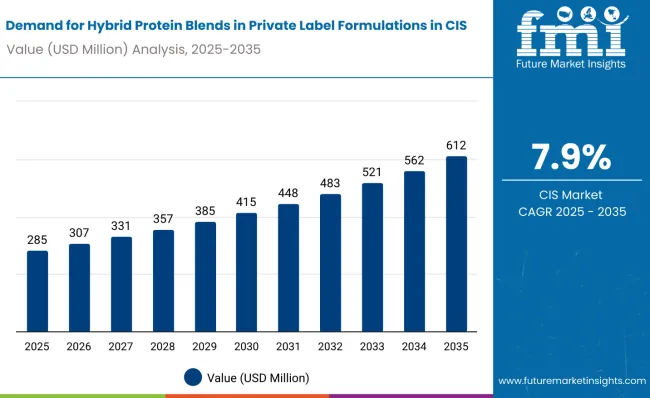
| Metric | Value |
|---|---|
| Industry Size (2025E) | USD 285 million |
| Industry Value (2035F) | USD 612 million |
| CAGR (2025 to 2035) | 7.9% |
This growth reflects both expanding private label penetration and increased per capita consumption in key urban centers. The rise in demand is linked to cost optimization strategies by retailers, growing protein awareness among consumers, and evolving nutrition trends.
By 2025, per capita consumption in leading CIS countries such as Russia, Kazakhstan, and Ukraine averages between 2.1 to 2.4 kilograms, with projections reaching 3.2 kilograms by 2035. Moscow leads among metropolitan areas, expected to generate USD 78 million in hybrid protein blend sales by 2035, followed by St. Petersburg (USD 34 million), Almaty (USD 18 million), Kiev (USD 16 million), and Minsk (USD 12 million).
The largest contribution to demand continues to come from plant-animal hybrid protein blends, which are expected to account for 62% of total sales in 2025, owing to optimal functionality, cost efficiency, and consumer acceptance. By distribution channel, hypermarkets represent the dominant retail format, responsible for 48% of all sales, while discount chains and cash-and-carry outlets are expanding rapidly.
Consumer adoption is particularly concentrated among health-conscious urban families and budget-conscious millennials, with income levels and urban density emerging as significant drivers of demand. While cost remains the primary motivator, the average price advantage over branded equivalents has increased from 18% in 2020 to 24% in 2025.
Continued improvements in formulation technology and supply chain optimization are expected to accelerate adoption across middle-income households. Regional disparities persist, but per capita demand in emerging markets like Belarus and Armenia is narrowing the gap with traditionally strong consumption centers in Russia and Kazakhstan.
The hybrid protein blends segment in private label formulations across the CIS is classified across several segments. By protein composition, the key categories include plant-animal hybrid blends, multi-plant protein combinations, whey-plant protein mixes, and casein-plant protein formulations. By distribution channel, the segment spans hypermarkets, discount chains, cash-and-carry outlets, convenience stores, and online grocery platforms. By application, formulations include dairy alternatives, protein bars and snacks, ready-to-drink beverages, and nutritional supplements.
By consumer profile, the segment covers health-conscious urban families, budget-conscious millennials, fitness enthusiasts, and elderly consumers seeking affordable nutrition. By region, countries such as Russia, Kazakhstan, Ukraine, Belarus, and Armenia are included, along with coverage across all CIS member states. By city, key metro areas analyzed include Moscow, St. Petersburg, Almaty, Kiev, and Minsk.
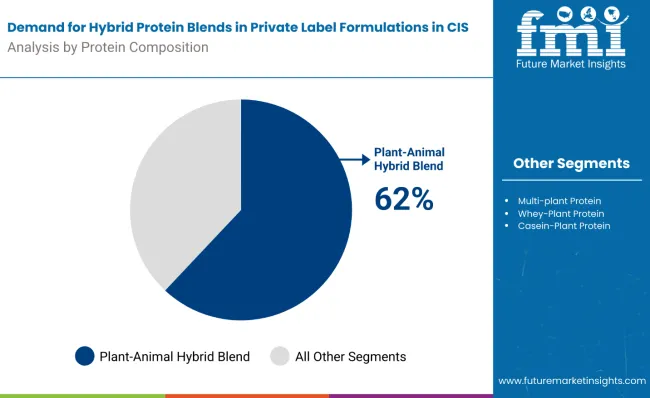
Plant-animal hybrid blends are projected to dominate sales in 2025, supported by optimal functional properties, cost efficiency, and consumer familiarity. Other formulations such as multi-plant combinations and specialized whey blends are growing steadily, each serving distinct nutritional needs.
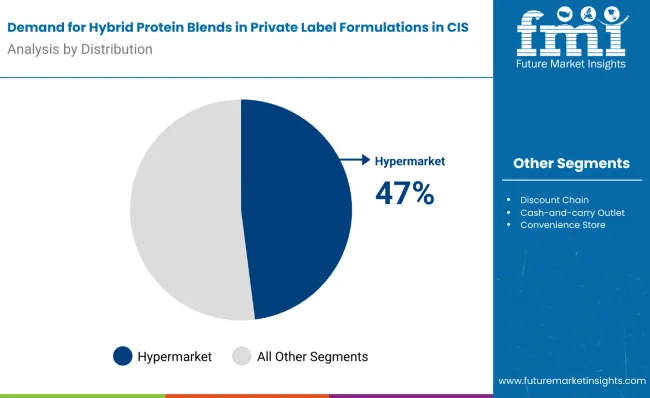
Hybrid protein blends in private label formulations across the CIS are distributed through a mix of modern retail and traditional trade channels. Hypermarkets are expected to remain the primary point of sale in 2025, followed by discount chains and cash-and-carry outlets. Distribution strategies are evolving to match price-conscious shopping behavior, with growth coming from both large format and value-oriented channels.
Hybrid protein blends in CIS private label formulations are utilized across various application categories, selected for functionality, cost optimization, and nutritional enhancement. Dairy alternatives remain the most widely used application, though protein bars and ready-to-drink beverages are gaining momentum. Product developers are increasingly exploring specialized formulations to meet evolving dietary and lifestyle demands.
The hybrid protein blends category in private label formulations appeals to a diverse consumer base across age groups, income levels, and lifestyle preferences. While motivations vary from health optimization to cost savings to convenience, demand is concentrated among four key demographic clusters. Each group brings distinct purchase behaviors, channel preferences, and product expectations.
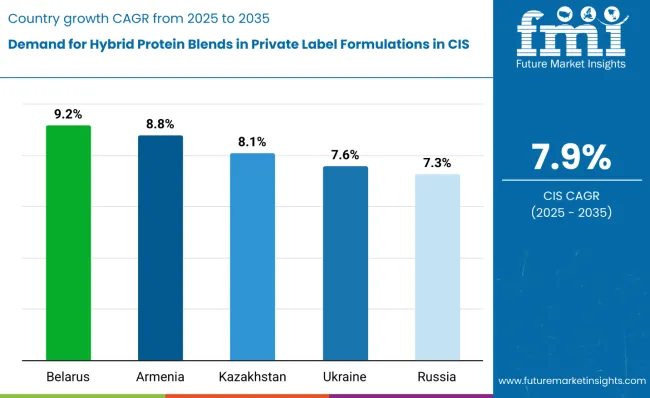
| Countries | CAGR (2025 to 2035) |
|---|---|
| Belarus | 9.2% |
| Armenia | 8.8% |
| Kazakhstan | 8.1% |
| Ukraine | 7.6% |
| Russia | 7.3% |
Demand for hybrid protein blends in private label formulations will not grow uniformly across every CIS country. Rising disposable income and faster retail modernization in smaller economies give Belarus and Armenia a measurable edge, while mature consumption centers such as Russia expand more steadily from a higher base. The table below shows the compound annual growth rate (CAGR) each of the five largest countries is expected to record between 2025 and 2035.
Between 2025 and 2035, demand for hybrid protein blends in private label formulations is projected to expand across all major CIS countries, but the pace of growth will vary based on retail modernization, disposable income trends, and baseline consumption levels. Among the top five countries analyzed, Belarus and Armenia are expected to register the fastest compound annual growth rates of 9.2% and 8.8% respectively, outpacing more established consumption centers.
This acceleration is underpinned by a combination of factors: rapid retail format development, growing middle-class purchasing power, and increasing availability of private label protein products across modern trade channels. In both countries, per capita consumption is projected to rise from 1.8 kg in 2025 to 3.9 kg by 2035, closing the gap with higher-consumption countries such as Russia and Kazakhstan. Private label penetration is also expanding faster in these regions, with new protein-enhanced product categories gaining traction in hypermarkets and discount chains.
Kazakhstan and Ukraine are each forecast to grow at CAGRs of 8.1% and 7.6% respectively over the same period. Both countries already maintain established modern retail ecosystems, with widespread access to private label protein products in hypermarkets, cash-and-carry outlets, and specialized nutrition stores. In Kazakhstan, growth is supported by a strong health and wellness consumer segment, increasing sports nutrition awareness, and rising uptake of affordable protein alternatives. Ukraine reflects similar dynamics, particularly among urban consumers and households seeking cost-effective nutrition solutions. In both countries, per capita consumption is projected to increase from 2.2 kg in 2025 to 4.1 kg by 2035, reflecting mainstreaming of hybrid protein formulations.
Russia, while maintaining the highest overall sales in absolute terms, is expected to grow at a CAGR of 7.3%, slightly below its CIS counterparts. The country already exhibits higher-than-average per capita intake (2.4 kg in 2025), extensive private label penetration, and a mature retail network. Growth will likely come from product innovation, premium positioning, and expansion into specialized nutrition categories rather than first-time trial.
Collectively, these five countries represent the core of regional demand for hybrid protein blends in private label formulations, but their individual growth paths highlight the importance of country-specific strategies in product development, pricing, and channel management.
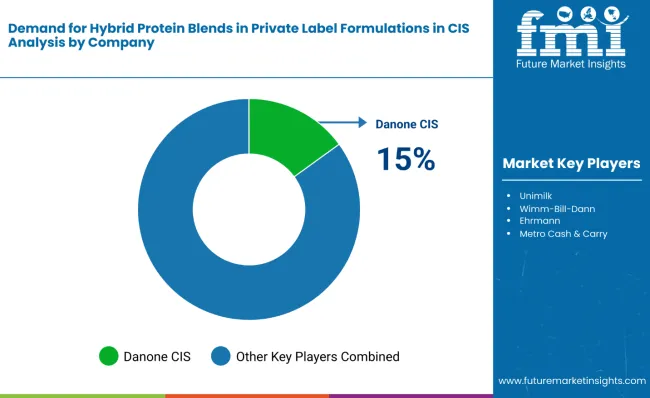
The competitive environment is characterized by a mix of established dairy and food manufacturers and newer, nutrition-focused entrants. Private label manufacturing capabilities rather than brand recognition remain the decisive success factor: the five largest suppliers collectively serve more than 15,000 retail outlets across the CIS and account for a majority of protein-enhanced private label SKUs in the category.
Danone CIS is the most established participant in hybrid protein formulations. The company leverages its extensive dairy infrastructure to offer white-label protein solutions across multiple categories, from yogurt drinks to nutritional supplements. Its manufacturing scale allows for cost-effective hybrid blending while maintaining consistent quality standards across the region.
Unimilk, part of the Danone ecosystem since acquisition, benefits from deep regional distribution networks to place hybrid protein dairy alternatives and functional beverages in mainstream retail channels. Post-integration synergies have enabled expanded capacity for private label manufacturing, particularly in plant-animal protein combinations.
Wimm-Bill-Dann, owned by PepsiCo, utilizes its beverage manufacturing expertise to develop ready-to-drink protein solutions for private label partners. Recent investments in protein processing capabilities have positioned the company as a key supplier for cash-and-carry and hypermarket chains seeking affordable nutrition products.
The next tier comprises specialized manufacturers and regional players. Ehrmann focuses on fermented dairy products with hybrid protein enhancement, targeting health-conscious consumers through private label partnerships with premium retailers. Metro Cash & Carry operates both as a distributor and private label developer, leveraging its B2B relationships to introduce protein-enhanced products across its network.
Private label programs at major retailers including Auchan, Lenta, and regional chains are expanding protein-enhanced product lines at price points 20-25% below international branded equivalents, creating opportunities for contract manufacturers while pressuring traditional dairy suppliers. Consolidation in manufacturing capabilities is therefore likely to continue as production scale and regulatory compliance become critical for maintaining shelf presence and cost competitiveness in this evolving category.
| Attribute | Details |
|---|---|
| Study Coverage | CIS sales and consumption of hybrid protein blends in private label formulations from 2020 to 2035 |
| Base Year | 2025 |
| Historical Data | 2020 |
| Forecast Period | 2025-2035 |
| Units of Measurement | USD (sales), Metric Tonnes (volume), Kilograms per capita (consumption) |
| Geography Covered | All CIS member states; country-level and city-level granularity |
| Top Countries Analyzed | Russia, Kazakhstan, Ukraine, Belarus, Armenia |
| Top Cities Analyzed | Moscow, St. Petersburg, Almaty, Kiev, Minsk |
| By Protein Composition | Plant-animal hybrid, Multi-plant combinations, Whey-plant mixes, Casein-plant formulations |
| By Distribution Channel | Hypermarkets, Discount chains, Cash-and-carry, Convenience stores, Online grocery |
| By Application | Dairy alternatives, Protein bars/snacks, RTD beverages, Nutritional supplements |
| By Consumer Profile | Health-conscious urban families, Budget-conscious millennials, Fitness enthusiasts, Elderly consumers |
| Metrics Provided | Sales (USD), Volume (MT), Per capita consumption (kg), CAGR (2025-2035), Share by segment |
| Price Analysis | Average unit prices by application and region |
| Competitive Landscape | Private label manufacturer profiles, contract manufacturing strategies, regional vs. international presence |
| Forecast Drivers | Per capita demand trends, retail modernization, price competitiveness, demographic shifts |
By 2035, total CIS sales of hybrid protein blends in private label formulations are projected to reach USD 612 million, up from USD 285 million in 2025, reflecting a CAGR of approximately 7.9%.
Plant-animal hybrid blends hold the leading share, accounting for approximately 62% of total sales in 2025, followed by multi-plant protein combinations and whey-plant protein mixes.
Belarus and Armenia lead in projected growth, registering CAGRs of 9.2% and 8.8% respectively between 2025 and 2035, due to retail modernization and rising disposable income.
Hypermarkets are the dominant sales channel (48% share in 2025), but cash-and-carry outlets and discount chains are growing at double-digit CAGRs, especially in value-conscious segments.
Major players include Danone CIS, Unimilk, Wimm-Bill-Dann, Ehrmann, and Metro Cash & Carry, with growing competition from regional private label manufacturers and retail chain partnerships.






Our Research Products

The "Full Research Suite" delivers actionable market intel, deep dives on markets or technologies, so clients act faster, cut risk, and unlock growth.

The Leaderboard benchmarks and ranks top vendors, classifying them as Established Leaders, Leading Challengers, or Disruptors & Challengers.

Locates where complements amplify value and substitutes erode it, forecasting net impact by horizon

We deliver granular, decision-grade intel: market sizing, 5-year forecasts, pricing, adoption, usage, revenue, and operational KPIs—plus competitor tracking, regulation, and value chains—across 60 countries broadly.

Spot the shifts before they hit your P&L. We track inflection points, adoption curves, pricing moves, and ecosystem plays to show where demand is heading, why it is changing, and what to do next across high-growth markets and disruptive tech

Real-time reads of user behavior. We track shifting priorities, perceptions of today’s and next-gen services, and provider experience, then pace how fast tech moves from trial to adoption, blending buyer, consumer, and channel inputs with social signals (#WhySwitch, #UX).

Partner with our analyst team to build a custom report designed around your business priorities. From analysing market trends to assessing competitors or crafting bespoke datasets, we tailor insights to your needs.
Supplier Intelligence
Discovery & Profiling
Capacity & Footprint
Performance & Risk
Compliance & Governance
Commercial Readiness
Who Supplies Whom
Scorecards & Shortlists
Playbooks & Docs
Category Intelligence
Definition & Scope
Demand & Use Cases
Cost Drivers
Market Structure
Supply Chain Map
Trade & Policy
Operating Norms
Deliverables
Buyer Intelligence
Account Basics
Spend & Scope
Procurement Model
Vendor Requirements
Terms & Policies
Entry Strategy
Pain Points & Triggers
Outputs
Pricing Analysis
Benchmarks
Trends
Should-Cost
Indexation
Landed Cost
Commercial Terms
Deliverables
Brand Analysis
Positioning & Value Prop
Share & Presence
Customer Evidence
Go-to-Market
Digital & Reputation
Compliance & Trust
KPIs & Gaps
Outputs
Full Research Suite comprises of:
Market outlook & trends analysis
Interviews & case studies
Strategic recommendations
Vendor profiles & capabilities analysis
5-year forecasts
8 regions and 60+ country-level data splits
Market segment data splits
12 months of continuous data updates
DELIVERED AS:
PDF EXCEL ONLINE
Private Label Pet Food Market Size and Share Forecast Outlook 2025 to 2035
Protein Labelling Market Size and Share Forecast Outlook 2025 to 2035
Protein Labeling Market
Demand of Protein Beverage Hybrids for Value Channels in Latin America Analysis - Size and Share Forecast Outlook 2025 to 2035
Hybrid Sleeve Cartridges Market Analysis - Size and Share Forecast Outlook 2025 to 2035
Private Wealth Management Service Market Size and Share Forecast Outlook 2025 to 2035
Hybrid Reactive Power and Harmonic Compensation Device Market Size and Share Forecast Outlook 2025 to 2035
Private Security Market Size and Share Forecast Outlook 2025 to 2035
Hybrid Vision Sensor Chips Market Size and Share Forecast Outlook 2025 to 2035
Labels Market Forecast and Outlook 2025 to 2035
Protein-Coating Line Market Forecast Outlook 2025 to 2035
Private Tutoring Market Forecast and Outlook 2025 to 2035
Hybrid Printing Market Forecast Outlook 2025 to 2035
Hybrid Boat Market Size and Share Forecast Outlook 2025 to 2035
Hybrid Metal-Paper Seamers Market Size and Share Forecast Outlook 2025 to 2035
Label Applicators Market Size and Share Forecast Outlook 2025 to 2035
Hybrid Sealing-Cut Machines Market Analysis - Size and Share Forecast Outlook 2025 to 2035
Hybrid Powertrain Market Size and Share Forecast Outlook 2025 to 2035
Labeling and Coding Equipment Market Size and Share Forecast Outlook 2025 to 2035
Private Electric Vehicle Charging Station Market Size and Share Forecast Outlook 2025 to 2035

Thank you!
You will receive an email from our Business Development Manager. Please be sure to check your SPAM/JUNK folder too.
Chat With
MaRIA